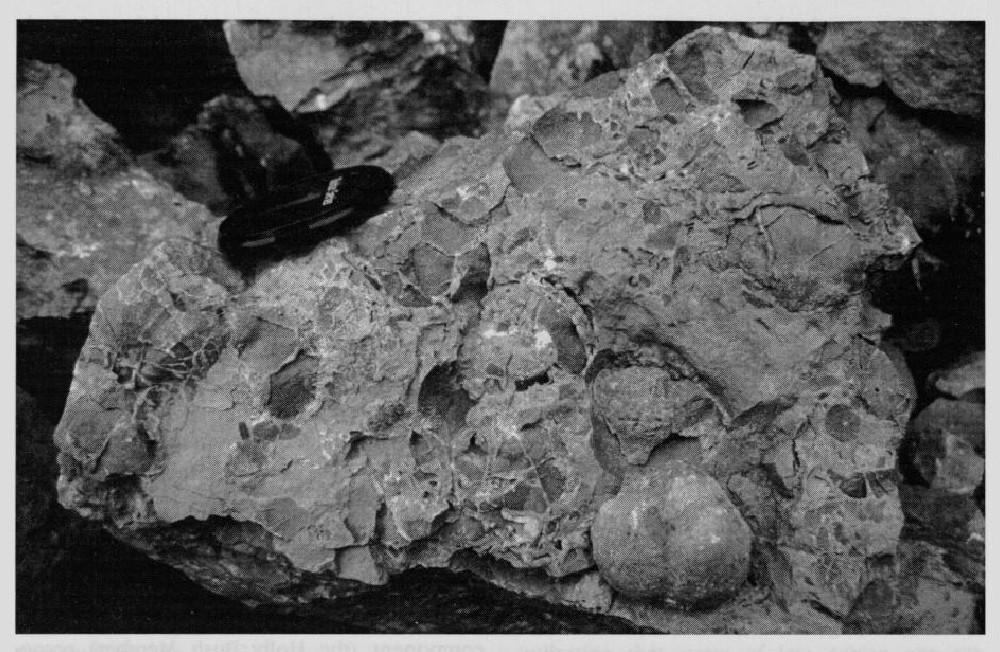Breedon Cloud Quarry, Leicestershire
Introduction
The Breedon Cloud Quarry GCR site is a working quarry (also referred to as 'Cloud Hill Quarry')
Description
Approximately 300 m of Lower Carboniferous strata are exposed at this site. The beds mostly dip towards the west, the dip increasing from 40° to 50° on the west side of the quarry to 60° to 90° on the eastern side. The lowest exposed beds are assigned to the Milldale Limestones. This unit, more than 200 m thick in the quarry, comprises grey to buff, bedded, crystalline dolostones with undulating bedding surfaces, commonly with clay or shaly partings up to 10 cm thick. Chert nodules in parts of the sequence show evidence of in-situ brecciation. A limestone interval with a significant siliciclastic component (the
The fauna of the Milldale Limestones is quite diverse. Brachiopods, including Levitusia humerosa and chonetoids (see
The top of the Milldale Limestones is truncated and eroded by the 'Main Breedon Discontinuity'. This is one of three sharp discontinuities recognized in the quarry (Ambrose and Carney, 1997) which dip westwards with the adjacent strata. The Lower Breedon Discontinuity occurs within the Milldale Limestones and the Upper Breedon Discontinuity occurs within the Cloud Hill Dolostone. The Main Breedon Discontinuity defines the base of the Cloud Hill Dolostone for which the quarry represents the type locality. In the northern part of the quarry the
In most of the quarry the 125 m-thick Cloud Hill Dolostone is not subdivided into formally defined stratigraphical units, but distinctive 'bedded dolostone' and 'mud-mound' facies are recognized (Ambrose and Carney, 1997). The bedded dolostones are crystalline with undulatory bedding planes, many with mudstone or clay partings. Crinoid remains are abundant in some beds, and brachiopods and corals also occur. Evidence of small-scale cross- stratification is also present; originally the bedded dolostones were probably skeletal grainstones. The mud-mound facies that makes-up the bulk of the formation is equivalent to Monteleone's (1973) Bioherm Member, and the upper four of five subdivisions recognized by Mitchell and Stubblefield (1941) above the level of the Main Breedon Discontinuity (see Ambrose and Carney, 1997, table 2). Buff to grey, massive, crystalline dolostones represent the dominant lithology. They are generally fossiliferous, containing a diverse brachiopod fauna, crinoids, corals, bivalves, gastropods, nautiloids and ammonoids, although most of the fossils have been destroyed by dolomitization (for a more complete faunal listing, see Mitchell and Stubblefield, 1941).
In the upper part of the face in the south-west corner of the quarry, bedded, nodular and crystalline dolostones of the Ticknall Limestone are exposed. The base of the formation is taken at the first palaeosol in a sequence of thinly bedded, fossiliferous dolostones.
Interpretation
Early attempts at correlation of the Breedon Cloud sequence hinged on comparisons with the outcrops to the north at Breedon-on-the-Hill: Fox-Strangways (1905, 1907) assigned these beds to the D Zone (Asbian to Brigantian) while Parsons (1918a) assigned them more specifically to the D2 Subzone (Brigantian). With the exception of a mid-Tournaisian determination based on spores (Mortimer et al., 1970), subsequent correlations of the lower part of the sequence were based on correlation of the beds containing Levitusia humerosa within the Milldale Limestones. These beds have been assigned a C2 (Alexander, 1934; Mitchell and Stubblefield, 1941) or C2S1 (Monteleone, 1973) age (i.e. Chadian to Arundian). More recently, they have been assigned an early Chadian age (Riley in Ambrose and Carney 1997).
The beds above the Main Breedon Discontinuity generally have been taken to be of Asbian age (Mitchell and Stubblefield, 1941; Monteleone, 1973). Palynological analysis indicates that the
The Main Breedon Discontinuity was described as a fault by Parsons (1918a) and Monteleone (1973), but Mitchell and Stubblefield (1941) regarded it as an unconformity. Ambrose and Carney (1997) interpreted the feature as an angular unconformity representing an interval of erosion and/or non-deposition spanning the early Chadian to late Holkerian time interval. According to Ambrose and Carney (1997) this is an unconformity of regional significance, corresponding to an episode of non-deposition or erosion also seen in the Widmerpool Gulf and on the Staffordshire Shelf (see Caldon Low Quarry GCR site report, this chapter). Changes in dip adjacent to the unconformity in Breedon Cloud Quarry indicate tectonic disruption along the surface, and the slumping evident in the
The locally high siliciclastic content of the rocks, the abundance of fragmentary skeletal remains, and evidence of grading and minor cyclicity indicate that the Milldale Limestones were deposited during storm events in a shallow proximal ramp setting (Ambrose and Carney, 1997). The strata of the
Of all the Lower Carboniferous Milers of the Hathern Shell; this site preserves the thickest sequence, spans the longest time interval and contains the most diverse suite of sedimentary rocks; in terms of stratigraphy, structure, palaeogeography and depositional environments it is among the most informative Dinantian section in the Midlands. The site is also significant as the type locality for the
Conclusions
Breedon Cloud Quarry is significant as the site where several locally important lithostratigraphical units (e.g. Cloud Hill Dolostone,
Furthermore, because of the rich diversity of its sedimentological, palaeogeographical, stratigraphical and structural features, this site has regional significance as one of the most geologically informative Lower Carboniferous sections in the English Midlands.

